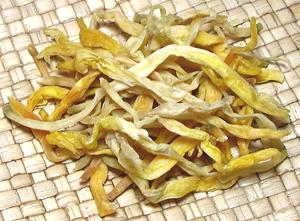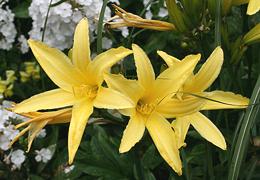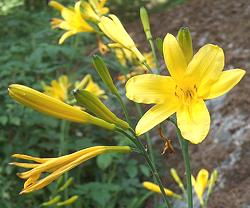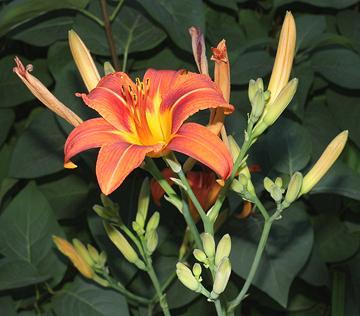
SAFARI
Users
Golden Needles
 [Gum jum choi, huang hua cai (Chinese); Dok mai jeen (Thai);
Hemerocallis species]
[Gum jum choi, huang hua cai (Chinese); Dok mai jeen (Thai);
Hemerocallis species]
These flower buds of the most aromatic of the daylilies (the ones on this page) are used fresh or dried where they are grown, but are available dried in most Asian markets worldwide.
These come in two ways: the bright yellow will probably have been treated with sulphur dioxide, the untreated will be a browner yellow (see Health & Nutrition below). If dull dark brown they are too old.
Golden needles are a common ingredient in China, Japan, Korea, Thailand and Vietnam. They are often paired with wood ear mushrooms in soups and stir fries.
Prep: Pour hot water over them and let them soak for
between 1/2 and 1 hour, depending on dryness. Longer soaking will deplete
the flavor. When they will be included in soups or similar they are
often tied in a knot so they don't get all tangled up, which also
helps prevent them from losing flavor to the liquid.
Citron Daylily
 [Long Yellow Daylily; Hemerocallis citrina]
[Long Yellow Daylily; Hemerocallis citrina]
This is one of the aromatic species used for dried buds called "Golden
Needles". It is native to East Asia, including China. The yellow flowers,
which are also edible fresh, are nearly 6 inches across the points.
Photo by Uleli distributed under license Creative Commons
Attribution-ShareAlike v3.0 Unported.
Lemon Daylily
 [Lemon Lily, Yellow Daylily; Hemerocallis lilioasphodelus]
[Lemon Lily, Yellow Daylily; Hemerocallis lilioasphodelus]
This is one of the aromatic species used for dried buds called "Golden
Needles". It is native to East Asia, including China but is also found
in northeastern Italy and Slovenia. The yellow flowers are also edible
fresh.
Photo by Anneli Salo distributed under license Creative
Commons
Attribution-ShareAlike v3.0 Unported.
Health & Nutrition
Sulphur Dioxide: This gas is a powerful preservative, maintaining color, softness and protecting from bacteria, but around 1% of Americans may have sulfite sensitivity. Among asthmatics this may be as high as 10%. In the United States, any product that has over 10 parts per million of sulfites must declare sulfites on the label.




